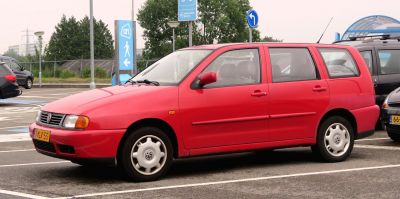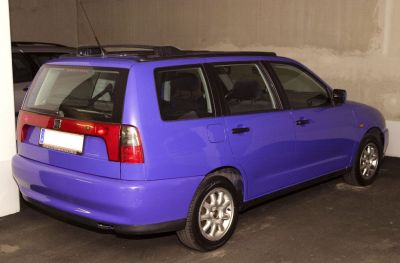 1999 Seat Cordoba Vario I (facelift 1999) Dimensions, Size & Specs
1999 Seat Cordoba Vario I (facelift 1999) Dimensions, Size & SpecsMeasurements of the 1999 Seat Cordoba Vario I, engineered for optimal performance and comfort
| Dimensions | |
|---|---|
| Length: | 4163 mm163.9 in13.7 ft |
| Width: | 1640 mm64.6 in5.4 ft |
| Height: | 1433 mm56.4 in4.7 ft |
| Trunk Capacity: | 350-455 liter12.4-16.1 cu ft |
| Trunk Capacity (Max): | 1250 liter44.1 cu ft |
| Weight Specifications | |
| Curb Weight: | 1020-1200 kg2249-2646 lbs |
| Maximal permitted Weight: | 1480-1660 kg3263-3660 lbs |
| Tire Specifications | |
| Tire Sizes: |
|
The Seat Cordoba Vario I (facelift 1999) is a refined station wagon variant produced between 1999 and 2002, designed to blend practicality with compact dimensions suitable for urban and family use. Measuring 4163 mm (163.8 inches) in length, 1640 mm (64.6 inches) in width, and standing 1433 mm (56.4 inches) tall, the Cordoba Vario offers a balanced footprint that ensures easy maneuverability and parking ease without compromising interior space. Its curb weight ranges from 1020 to 1200 kilograms (2249 to 2645 pounds), allowing for efficient fuel consumption while maintaining structural stability. The maximum permissible weight varies between 1480 and 1660 kilograms (3262 to 3661 pounds), accommodating passengers and cargo comfortably. One of the standout features of this model is its versatile luggage capacity: providing 350 to 455 liters (12.4 to 16.1 cubic feet) of cargo space with rear seats upright, which expands impressively to 1250 liters (44.1 cubic feet) when the rear seats are folded down, catering to larger load requirements. The Cordoba Vario supports multiple tire sizes including 175/70 R13, 185/60 R14, and 185/55 R15, offering options that balance ride comfort and handling. This generation of the Seat Cordoba station wagon is well-suited for drivers seeking a compact vehicle with ample storage and flexible interior space, making it an excellent choice for families and practical daily transportation needs.
Discover the standout features that make the 1999 Seat Cordoba Vario I a leader in its class
Have a question? Please check our knowledgebase first.
The Seat Cordoba Vario I facelift 1999 measures 4163 mm (163.8 inches) in length, 1640 mm (64.6 inches) in width, and 1433 mm (56.4 inches) in height. These dimensions characterize it as a compact station wagon, offering a practical exterior size that balances maneuverability with interior space efficiency, suitable for urban and suburban driving conditions.
The curb weight of the Seat Cordoba Vario I facelift 1999 ranges between 1020 kg (2249 lbs) and 1200 kg (2645 lbs). This relatively moderate weight contributes to the car's nimble handling and fuel efficiency. The lighter curb weight in the lower range results in better acceleration and responsiveness, while the higher end might include models with additional equipment or stronger engines.
The maximum weight of the Seat Cordoba Vario I facelift 1999 ranges from 1480 kg (3262 lbs) to 1660 kg (3661 lbs). This includes the vehicle's curb weight plus passengers, luggage, and any additional cargo. The considerable difference between curb and maximum weight shows that the car is designed to safely carry a significant payload, making it practical for families or transport of goods, especially given its station wagon body style.
The luggage capacity in the Seat Cordoba Vario I ranges from 350 liters (12.4 cubic feet) with the rear seats upright to a spacious 1250 liters (44.1 cubic feet) when the rear seats are folded flat. This versatility is ideal for everyday use and larger cargo, supporting the needs of users who require flexible storage space — from groceries to larger items such as sports equipment or DIY materials.
The Seat Cordoba Vario I facelift 1999 came with several tire size options, including 175/70 R13, 185/60 R14, and 185/55 R15. These size variations allowed for different handling dynamics and ride comfort depending on the trim or user preference. Smaller tires like the 13-inch size offer a more compliant ride, while larger 15-inch tires generally improve cornering and grip.
Yes, the Seat Cordoba Vario I facelift 1999 fits comfortably into a standard residential garage. The car's length of 4163 mm (163.8 inches), width of 1640 mm (64.6 inches), and height of 1433 mm (56.4 inches) make it compact enough for most typical garages with standard internal dimensions of around 6 meters in length and 3 meters in width. This ease of parking and storage adds to its practicality for everyday use.
Compared to its predecessor, the original Seat Cordoba Vario (pre-1999), the facelifted 1999 model saw subtle updates but maintained a similar overall footprint. Generally, the length and width stayed close to previous dimensions, preserving the compact station wagon size. Slight refinements improved aerodynamics and styling without significantly changing cabin or cargo space, ensuring continuity in practicality and maneuverability.
In comparison with similar compact station wagons from the late 1990s and early 2000s, the Seat Cordoba Vario I facelift 1999 offers competitive dimensions and cargo capacity. Its length of 4163 mm and luggage capacity up to 1250 liters with seats folded are on par with rivals like the Volkswagen Golf Variant or the Ford Focus Wagon. The combination of modest width and weight made it an attractive option for drivers prioritizing practicality without sacrificing ease of parking or fuel efficiency.
With a height of 1433 mm (56.4 inches), the Seat Cordoba Vario I facelift 1999 offers a balance between a low-profile aerodynamic design and sufficient interior headroom. This height ensures that most passengers have comfortable seating positions without feeling cramped, enhancing the overall driving comfort. Additionally, the moderately low roofline contributes to stable handling dynamics and good fuel economy by reducing drag.
The varying curb weight between 1020 kg and 1200 kg reflects differences in engine options, trim levels, and equipment packages. Lighter variants tend to offer better fuel economy and agility, suiting drivers focused on efficiency and urban maneuverability. In contrast, heavier variants may provide enhanced features or more powerful engines, appealing to those prioritizing performance or additional comfort features. This range allows buyers to select a configuration that best matches their driving style and needs.
Discover similar sized cars.

| Production: | 1994-2000 |
|---|---|
| Model Year: | 1994 |
| Length: | 4137 mm162.9 in |
| Width: | 1640 mm64.6 in |
| Height: | 1433 mm56.4 in |

| Production: | 1996-1999 |
|---|---|
| Model Year: | 1996 |
| Length: | 4144-4163 mm163.1-163.9 in |
| Width: | 1640 mm64.6 in |
| Height: | 1427-1433 mm56.2-56.4 in |
